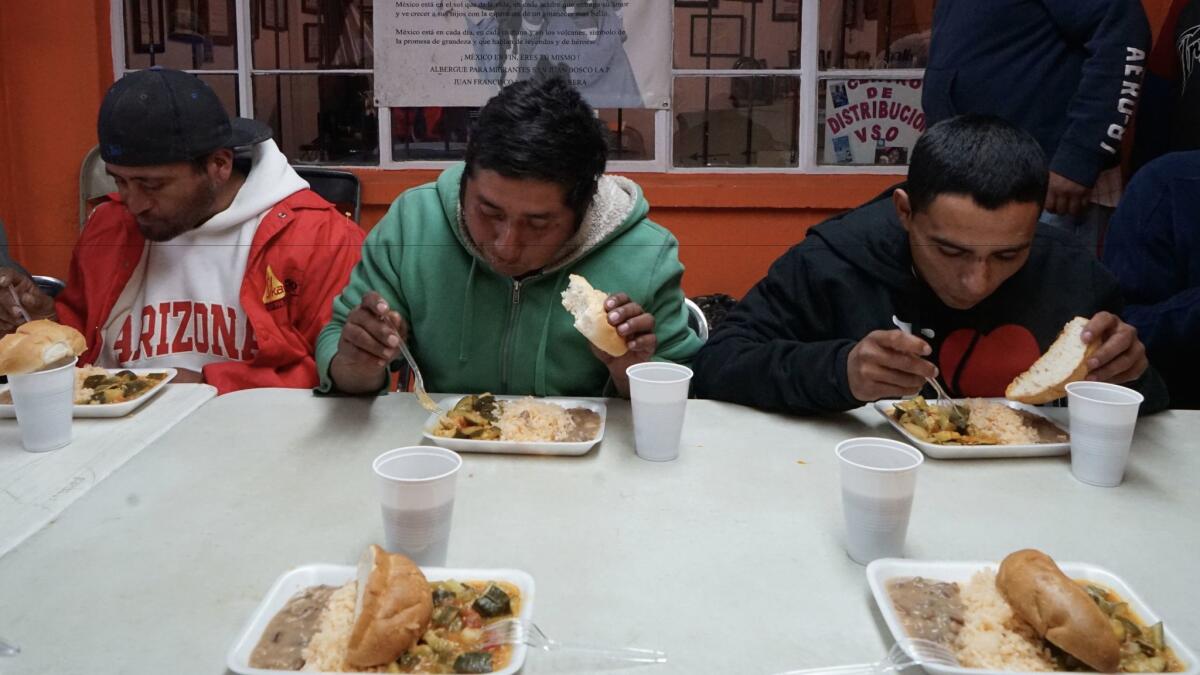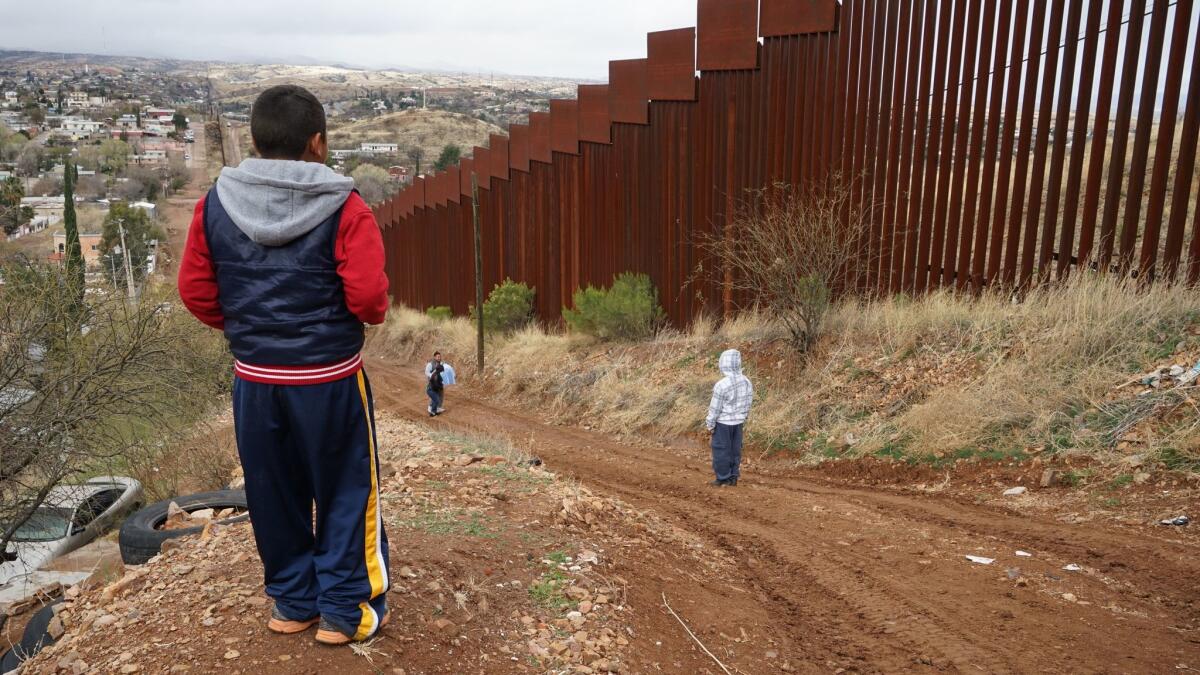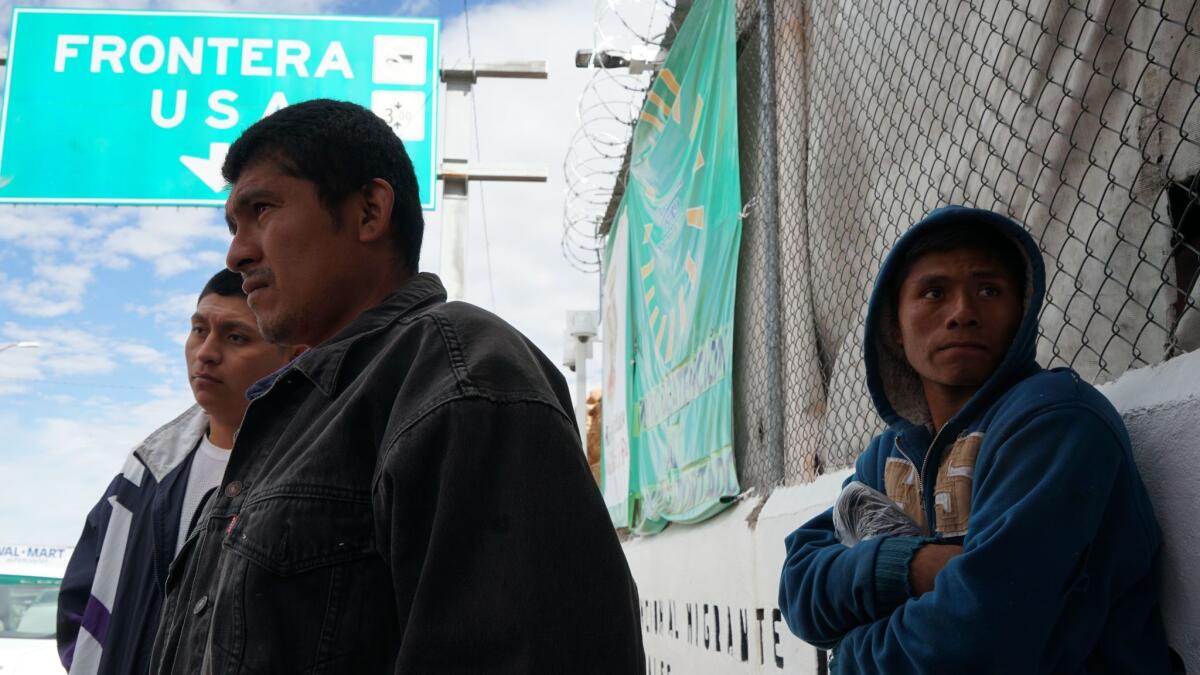On the other side of the wall: Mexicans on the border are ‘psychologically traumatized’

- Share via
Reporting from Nogales, Mexico — At a shelter here across the border from Arizona, volunteers are stocking food and other supplies in case of a large influx of deportees from the other side.
“We don’t want any surprises from Mr. Trump,” Juan Francisco Loureiro, director of the Don Bosco migrant center, said of the U.S. president’s plans to step up deportations. “We need to be ready.”
Along the border, dejected recent deportees and new arrivals from the south headed for the U.S. are weighing whether to vault for the north or just go home — essentially, admitting defeat.
“It’s just too hard now with Trump,” said Alejandro Ramos Maceda, 33, recently deported after being picked up on a traffic charge in St. Louis — where he said he has a wife and two daughters, both U.S. citizens.

Discouraged, Maceda said he plans to stay in Mexico for the moment, a choice that many other deportees with families in the United States have reluctantly embraced.
“Maybe my wife will come visit,” he said, his tone not betraying much hope.
Not one post has been driven into the ground for President Trump’s proposed new border wall. There has been no sign of ramped-up Border Patrol forces as part of the administration’s promised enforcement buildup.
But interviews on the Mexican side of the frontier suggest that, in just a few weeks, the new president has had a profound effect on how people in the border region act, plan and, perhaps more importantly, think. Although his strategy has scarcely begun to be enacted, Trump is deep in people’s heads.
“It’s just a lot harder to cross than we thought,” said Vicente Vargas, 15, one of five teenagers from Mexico’s Puebla state who said they were going back home, discouraged at how difficult, and costly, it is to get over the border — especially given the likelihood that they would be apprehended if they made it to the other side.

That the current difficulties have nothing to do with Trump doesn’t matter: Vicente and his downcast colleagues blame the new president’s border blueprint. Even deportees picked up months before Trump took office seem to point a finger at the new administration.
“There’s just a lot of uncertainty right now,” said Jesus Arturo Madrid Rosas, the representative here for Grupo Beta, a Mexican government aid organization that provides assistance to migrants. “People don’t know what’s going to happen. Maybe that’s keeping some people back.”
He and others stressed that many factors — blustery weather, enhanced border enforcement from the pre-Trump era, ever-increasing fees charged by smugglers — are probably slowing down the northbound human traffic. Rumors about both U.S. amnesties and crackdowns have long filtered back to “sending” communities and swayed the behavior of prospective border-jumpers. The coming spring months are usually the busiest.
But Trump — or “Troomp,” as the president’s name is pronounced here, without much affection — often gets the blame, or credit, depending on one’s point of view.
“This Trump, I don’t agree with him, but he’s doing what his people want,” said Eliseo Estrada, a burly Nogales police commander standing on a high point where the existing border fence — an undulating, 15-foot-high curtain of steel shafts — separates this bustling city from the much smaller Nogales, Ariz. “Mexico could use a strong president too,” he said.
Down the hill in town, where backyards cluttered with bicycles, patio tables and toys push against the frontier fence, shrines mark the spot where, in 2012, a Border Patrol agent firing through a gap in the fence emptied about 10 rounds into a Mexican teenager, Jose Antonio Elena Rodriguez. The much-anticipated murder trial of the agent, Lonnie Swartz, is scheduled to begin this year.

Even people smugglers, known here as “coyotes” — whose fees are adjusted upward as crossing becomes more difficult — say the tough talk on the other side has left many uncertain.
“People are psychologically traumatized,” said one veteran smuggler, a slim raconteur with a tequila laugh, who asked not to be identified for fear of arrest.
On the U.S. side too, word of the Trump crackdown is causing anxiety as people wonder about relatives and neighbors in the United States who may be deported — or about those in Mexico who may be permanently separated from loved ones.
“That’s all anyone is talking about, Trump, the border, deportations, roundups,” said Sheriff Tony Estrada of Santa Cruz County, in southern Arizona. “You hear it in the cafes, in the restaurants, everywhere,” said Estrada, who was born on the Mexican side and emigrated as an infant with his family to Nogales, Ariz. “People are scared.”
An image at an art installation along the fence depicts the mustachioed visage of Jesus Malverde, an early 20th century Robin Hood figure who is much revered today as patron saint of Mexico’s narco-traffickers and outlaws.
Despite the enforcement crunch of recent years, illicit drugs continue to pass through — via narco-tunnels burrowed beneath the fence; in loads tossed over or hoisted across; and in semi-trailers and cars passing through the pair of busy ports of entry, sometimes sprinkled with especially potent chili pepper extract to dissuade sniffing dogs.
Long before the Trump era, successive U.S. administrations poured billions of dollars into hiring more guards, improving fencing and deploying military-style hardware, from ground sensors to drones to floodlights and camera-mounted observation towers. There is no doubt the investment has made illegal crossing more difficult and expensive — not to mention more dangerous, as is clear from the scores of migrants who have perished in recent years trying to cross through the Arizona desert.
These days, no one ventures forward here without a smuggler. The era of large groups scrambling on their own is long gone. The criminal syndicates that run drugs also control the people-smuggling trade. “The mafia demands their cut,” said the loquacious coyote, who has been at it for more than two decades.
Unseen lookouts, known as puntos, closely observe the border strip, reporting back to their superiors on any activity.
East of town, where the imposing steel border fence gives way to an easy-to-hurdle barrier of rusted old locomotive rails topped with barbed wire, there was plenty of evidence of past crossers: empty water bottles, discarded food packages, doused campfires. Footprints and debris lined an eerie, abandoned graveyard known as the Chinese cemetery, the apparent resting place of many from the region’s once-thriving Chinese community, largely forced out in an early 20th century wave of xenophobia.
But finding anyone crossing in a zone that was once filled with prospective border-jumpers was impossible.
Two Border Patrol agents, their green-and-white vehicle parked on a dirt road on the U.S. side, seemed skeptical that Trump’s planned wall would be effective, given the rough, mountainous terrain and summer thunderheads.
“A wall would probably wash out once the monsoons come,” concluded one agent, speaking from across the fence and declining to be identified because he was not authorized to speak.
Coyotes now charge about $4,000 a head to smuggle the undocumented to Tucson, just 60 miles north, and $6,000 to get to Phoenix. The fees are about five times what they were a decade ago, when this stretch of international boundary was by far the busiest in the Southwest. Between fiscal 2006 and 2016, however, annual Border Patrol apprehensions in the Tucson sector, which includes the Nogales border strip, plunged from almost 400,000 to about 65,000.
In fact, Trump’s border buildup comes at a time when illegal immigrant traffic is generally way down. Across the Southwest border region, agents in fiscal 2016 recorded 408,870 apprehensions — compared with 1.1 million in 2006 and 1.6 million in 2000. Non-Mexican nationals, mostly Central Americans, now outnumber Mexicans detained.
Notwithstanding the considerable challenges, not everyone is deterred. It is an article of faith here that no one can stop those determined to cross. The smuggler said he was passing three clients the next evening. Many deportees say they have no choice but to get back.
“My life is on the other side,” said Oscar Felix, 48, who was found with other disheveled and exhausted deportees at a Catholic shelter that provides breakfast to migrants. “Of course I will return.”
Felix said he had lived for 30 years in the Phoenix area after entering the U.S. illegally three decades earlier, and worked as a mechanic. He has four U.S.-born children, he said, from 1 to 14 years of age. He said he was arrested in December on an outstanding warrant for driving without a license, was jailed for three days and then turned over to immigration agents, who held him for 2½ months before he was removed in February.
He said he planned to visit family in Ciudad Obregon, his hometown, and then head back across. He had no doubt he would make it.
“I have no life in Mexico; my life, my family is on the other side,” the distraught Felix said as he stood in a driving, cold rain outside the free-breakfast site. “It’s not about Trump. It’s about my family. I have to go back to Phoenix.”
To read the article in Spanish, click here
Twitter: @mcdneville
Special correspondents Cecilia Sanchez in Mexico City and Liliana Nieto del Rio in Nogales contributed to this report.
ALSO
Did a Mexican migrant leap to his death at the border minutes after deportation?
Meet El Salvador’s growing middle class: Deportees from the U.S.
Trump needs to stop terrifying immigrant families and consider the real cost of mass deportations
More to Read
Sign up for Essential California
The most important California stories and recommendations in your inbox every morning.
You may occasionally receive promotional content from the Los Angeles Times.










